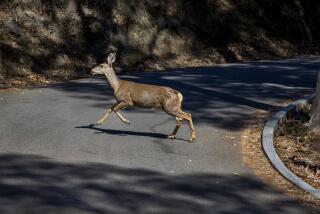TV Reviews : ‘Eagle’: The Cost of Taming the Wilderness
- Share via
“Land of the Eagle,” a special eight-hour presentation of the PBS series “Nature,” tackles an amazingly broad topic: the intertwined history of the people and animals of North America, dating from the arrival of the first European settlers in the early 16th Century.
The slow-paced, darkly fascinating program--a combination of stunning nature documentary footage, archival etchings and photographs and readings of works by settlers and American Indians--was produced by WNET-TV in New York and the BBC and is narrated by longtime “Nature” host George Page. It airs in two-hour segments Sunday through Wednesday (each night at 8 p.m. on KCET Channel 28 and KPBS Channel 15, and at 7 p.m. on KVCR Channel 24) and will be rebroadcast in its entirety on Thursday from 10 a.m. to 6 p.m. on KCET.
Divided into hourlong chapters and examining such varied climes as Virginia’s Chesapeake Bay, the Florida Everglades and California’s San Joaquin Valley, each segment focuses on two themes: description of the regions’ animal life--both past and present--and the pioneers’ efforts to annex and “tame” the North American “wilderness” for their own use and profit, with scant regard for the lives of the American Indians who had harmoniously inhabited these lands for centuries.
The series stresses that while the actions of the settlers ultimately may have resulted in the prosperous lifestyle that many North Americans enjoy today, it’s essential that we learn from our mistakes and be vigilant to prevent further extinction of endangered species and loss of wildlife habitats.
“Eagle” depicts the bravery of settlers and the philanthropic attitudes of people such as conservationist John Muir, and points out that, despite the onslaught of progress, much animal life continues to thrive.
It also delineates greed and destruction, such as the description of the death from disease and starvation of 80% of the Indians in California by 1860, primarily as a result of the arrival of hordes of prospectors for the Gold Rush.
This seesawing between negative and positive information sometimes results in disquieting segues. And the wildlife footage, as glorious as it is, sometimes just drags on.
Flaws aside, “Eagle” is often captivating. It embraces the renewal capacity of nature while also addressing unseemly facts about our forefathers that have either been suppressed or forgotten.
More to Read
The complete guide to home viewing
Get Screen Gab for everything about the TV shows and streaming movies everyone’s talking about.
You may occasionally receive promotional content from the Los Angeles Times.






